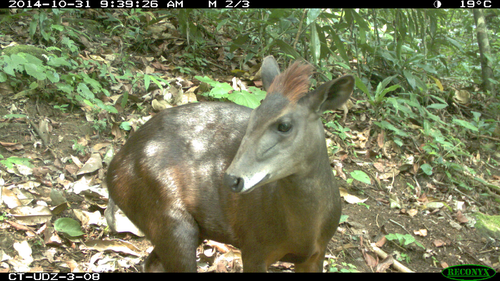
MUSE (Museo delle Scienze) joined EU BON's Associated Partners family in November 2015. We are now happy to present some more information about the museum and its initiative - the TEAM network.
MUSE is involved in biodiversity monitoring both locally in Trento Province, southeastern Alps, and globally. In particular, its Tropical Biodiversity Section runs a long-term biodiversity research and monitoring programme in the Udzungwa Mountains of Tanzania, an outstanding site for biological diversity and endemism. In 2009, this site became the first in Africa to enter the TEAM Network, a global programme for the standardized monitoring of biodiversity across the tropical moist forests.


Camera trap images from the MUSE site in Tanzania; Credit: MUSE – Science Museum
Started in 2002 by Conservation International (CI), the Tropical Ecology Assessment and Monitoring (TEAM) Network (http://www.teamnetwork.org/ ) – grew to a coalition in 2009 that includes CI, the Smithsonian Tropical Research Institute and the Wildlife Conservation Society. TEAM has collected and made publicly available more than 2.5 million photos from camera traps in tropical forests across the planet. With support from Hewlett Packard Enterprise, formerly Hewlett Packard Company, the TEAM Network is now able to analyze this global data set in near real-time and provide data-driven insights for improving natural resource management.
A major analysis of TEAM data was recently published in PloS Biology and caught vast media coverage as it represents the first standardized assessment of its kind for population trends of tropical forest mammals and terrestrial birds (http://journals.plos.org/plosbiology/article?id=10.1371/journal.pbio.1002357). TEAM researchers monitored 244 species of ground-dwelling mammals and birds in 15 protected areas spanning tropical regions in Central and South America, Africa and Southeast Asia. They analyzed more than 2.5 million pictures captured by more than 1,000 camera traps and found that 17% of the animal populations they monitor increased in number while 22% remained constant and 22% decreased. The Wildlife Picture Index (WPI) Analytics System was developed in partnership with Hewlett Packard Company.
WPI is an index that summarizes the occupancy trends at community level and is an official indicator to monitor progresses against the Aichi Targets under the CBD (http://www.bipindicators.net/wildlifepictureindex).
In 2015, MUSE – Science Museum established in a Natural Park in the Brenta Dolomites (near Trento) the first site in Europe of systematic camera trapping that adopts the standardized protocol developed by the TEAM Network. This entails the sampling of 60 camera trap locations within an area of 200-250 km2 for 30 days each year, to derive data that are suitable to occupancy analysis and that can allow, as demonstrated by the recent paper in PLoS Biology, to assess population trends using state-of-the-art ecological methods.
MUSE’s scientists hope that this protocol may attract the interest of other partners within the EU BON family that may be keen to replicate this sampling at other sites in Europe.




 RSS news
RSS news Print this article
Print this article
